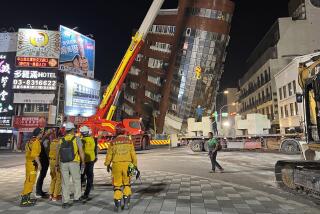Nepal earthquake death toll tops 3,700
Terrifying aftershocks continued to roil Nepal on Sunday, sending people screaming into the driving rain and complicating efforts to rescue survivors after a massive earthquake killed more than 3,700 people in the impoverished mountain nation and surrounding countries.
In Katmandu, Nepal’s capital, just 50 miles from the epicenter of Saturday’s 7.8 quake, thousands were camped out in the streets, in parks and on sports fields, afraid that the aftershocks could bring buildings down on them. Rescue workers dug through piles of rubble, trying to reach survivors.
On Mt. Everest, helicopter teams evacuated dozens of climbers who were critically injured when an avalanche triggered by the quake swept through a base camp packed with people preparing to scale the world’s highest peak. But the flights had to be suspended when Sunday’s aftershocks sent more ice, snow and rocks tumbling down the mountain.
Dozens more climbers remained stranded at camps at higher elevations.
Local and international aid agencies were scrambling to get food, water, shelter, medical supplies and hygiene items to those in need. As planeloads of aid and personnel arrived from neighboring countries, some of the aircraft had to circle the airport in Katmandu while waiting for aftershocks to subside.
By Monday morning, authorities in Nepal were reporting that 3,617 people had died and that thousands more were injured in that nation alone. That does not include at least 17 people reported killed on Mt. Everest, three of them Americans.
Tom Taplin, a filmmaker from Santa Monica, was making a documentary about the base camp when the avalanche hit, his wife, Cory Freyer, told reporters. A passionate mountaineer, he wrote a book about his experiences climbing South America’s tallest peak, Aconcagua, in the early 1990s.
Also killed was Dan Fredinburg, a Bay Area Google executive described by friends as an avid adventurer who had scaled mountains, swam with sharks and, after conquering Mt. Everest, had plans to kite surf across Antarctica.
Marisa Eve Girawong, who was reportedly from Edison, N.J., was working as a camp doctor with the Seattle-based Madison Mountaineering company when the avalanche struck. “Our hearts are broken,” the company said in a statement confirming her death.
Friends reaching out without success to a missing Santa Monica couple, Michelle Page and Daniel Adams, continued to hold out hope that they would be found alive. “I’m hoping they are too busy attending to others, that they haven’t had the time to check in,” said Susan Klos, a longtime friend.
At least 69 people died in India, most of them in the northeastern border state of Bihar, with additional deaths reported in Bangladesh and China’s Tibet region.
Rescue workers were still struggling to reach remote mountain villages, some of which have no cellphone coverage and can be accessed only by foot trails. But initial reports indicated that a number of communities were devastated, and the casualty toll was expected to rise.
“We are extremely concerned about the fate of communities in towns and villages in rural areas closer to the epicenter,” Jagan Chapagain, the International Federation of Red Cross and Red Crescent Societies director for the Asia Pacific region, said in a statement. “Access roads have been damaged or blocked by landslides and communications lines are down, preventing us from reaching local Red Cross branches to get accurate information.”
Hardest hit appeared to be Nepal’s densely populated Katmandu Valley, where the quake ravaged ancient neighborhoods filled with historic temples and poorly constructed apartment buildings. More than 1,000 people died there, according to the country’s Home Ministry.
In newer areas, many buildings withstood the quake, but their inhabitants were too afraid of the violent aftershocks to remain inside.
“No one is sleeping indoors,” said Tamdim Dorjee, a Katmandu resident reached by phone. “All the buildings are empty. All the people are out on the football grounds and other open spaces.”
Soldiers were digging through collapsed homes with their bare hands and carrying away the dead.
“Many people are still under the rubble,” Dorjee said. “There is no modern machinery to pick up the bricks. Everything is by hand. There is no electricity.”
Sarbottam Shrestha, a doctor who lives in the relatively unscathed Kopeshwar neighborhood, said four or five families had pitched tents in his yard. “There are 20 people here, including my family,” he said by phone.
With most markets and shops closed, he wondered how he would feed them all. There was food left in warehouses, he said, but shopkeepers were too afraid to collect it.
“Our family just had dinner,” he said. “We have rice and flour, but not vegetables and meat.”
Frances Howland, a nurse reached by phone in Katmandu, described the panic when the worst of Sunday’s aftershocks, a 6.7 temblor, hit in the early afternoon.
“We have a lot of aftershocks, but this one was really significant,” she said. “When that happened, people were really freaked out and running in the streets.”
Some of the city’s major hospitals were damaged in the quake. “Grande International is badly cracked and all the patients have been evacuated,” Howland said. “Another hospital, Norvic, has also been badly damaged. They’re seeing patients outside across the road.”
Emergency rooms were overflowing with patients, some of them with severed limbs and severe head and back injuries. Many were being treated on beds and mattresses that the staff had dragged into parking lots and gardens.
With much of the city’s transportation network shut down, families were having a hard time getting injured relatives to medical facilities.
Sanjeev Lal’s 72-year-old mother, Bharati Devi, injured her back while fleeing their cramped apartment in the city’s Baneshwor neighborhood. When he was finally able to get her to the nearby Bharosa Hospital on Sunday, he was told there were no X-ray facilities.
“Now we have to move my already frail mother to another location,” Lal said, visibly frustrated as he negotiated a taxi fare in the largely empty roads of Baneshwor.
Thousands were camped out at Tudikhel, a vast, grassy area in the center of Katmandu, turning one of the city’s best known landmarks into a makeshift tent city. Heavy rain added to the misery of those sheltering there under leaky tarps.
“We have nowhere to go, and now I am running out of money to buy food supplies,” said Raghubir Patel, a garment trader from Rautahat, in eastern Nepal. “When will the relief material be brought here?”
Organizers of a yoga retreat that had been taking place at Tudikhel were dishing out rice and potatoes, and companies that supply drinking water had dropped off several tanks.
“People have been pooling their resources together, but there will soon be problems with food and with water,” said Santosh Sharma, emergency response coordinator in Katmandu for the humanitarian group CARE.
World leaders rallied to aid the stricken Asian nation, pledging millions of dollars in aid.
The Pentagon said it had sent a cargo jet carrying 45 square tons of humanitarian supplies and nearly 70 personnel, including a U.S. Agency for International Development disaster assistance response team and an urban search-and-rescue team from Fairfax County, Va., outside Washington.
The flight was expected to arrive at Tribhuvan International Airport in Nepal on Monday, said Col. Steve Warren, a Pentagon spokesman. It will join a C-130 cargo plane and 26 personnel who were already in Nepal to conduct a training exercise.
Israel was sending a 260-person team, including search-and-rescue units and medical personnel equipped to set up a field hospital within 12 hours of landing in Katmandu. Japan was sending a 72-person rescue team.
As passengers crowded Katmandu airport looking for flights out of the country Sunday, others were trying to get home to check on loved ones.
Sujit Thapa, a Nepalese man boarding a flight in Kunming, China, for Katmandu, had been traveling when he got a news alert on his phone saying the quake had struck. He was unable to reach his family members for six hours. When he got through, he learned that they were all right but that most of the houses in his village had collapsed.
“The cement houses are still standing, but they’re cracked so it’s scary to go in,” he said. “I’m frustrated as well as tense. I’m dying to meet my family. I know there have been no serious casualties in my family, but I want to confirm with my own eyes.”
He said he was used to earthquakes after spending seven years working for an automotive company in Japan.
“But in Japan houses are built to resist earthquakes,” he said. “In Nepal, it’s a hodgepodge. There’s no planning. That’s why there were so many casualties.”
Special correspondent Rai reported from Katmandu and staff writer Zavis from Los Angeles. Staff writers Julie Makinen in Katmandu and Kunming and Sarah Parvini and Matt Pearce in Los Angeles, special correspondent Parth M.N. in Mumbai, India, and Times staff in Beijing contributed to this report.
Follow @JulieMakLAT and @AlexZavis on Twitter
ALSO
Katmandu’s poorly constructed buildings worsen quake outcome
Images of devastation emerge from Nepal earthquake
Map: Nepal earthquake and aftershocks
More to Read
Start your day right
Sign up for Essential California for news, features and recommendations from the L.A. Times and beyond in your inbox six days a week.
You may occasionally receive promotional content from the Los Angeles Times.







